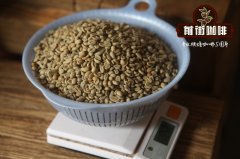The evolution of Pacamara coffee beans and the characteristics of Pacamara coffee beans.

Professional coffee knowledge exchange more coffee bean information please follow the coffee workshop (Wechat official account cafe_style)
Many years ago, most buyers in the boutique coffee industry avoided large-grain coffee, such as Maragogype and Pacamara. Large-grain coffee grown in low and middle elevations usually showed less pleasant vegetable or woody flavors. At that time, most coffee farmers had not yet tried to grow in high altitude areas. It was not until Incht Manor won the championship of Cup of Excellence with Pacamara variety many times that boutique coffee lovers slowly realized that the original Pacamara produced at high altitude had such a rich and varied flavor.
Pacamara (Pacamara) has a peculiar plant shape and raw bean shape-huge leaves, tall trees, huge raw beans. It is known as the strange variety of Saudi Arabia.
He was so unknown that he even made his debut in the COE competition in 2003 and 2004, because the judges thought the flavor was too strange to give high marks. Until 2005 COE began to shine, in 2006 directly arranged to host the top four COE in Saudi Arabia, and in 2008-10 Guatemala COE was directly won by the Pacamara direct champion of Incht Manor for three years! From then on, he established the position of being the leader of the raw beans.
Unlike naturally evolved varieties such as geisha, bourbon and iron pickup, Pacamara is not naturally evolved or crossed naturally, but is bred by a group of excellent coffee breeders in El Salvador!
In 1958, more than half a century ago, the Department of Genetics and breeding of the Salvadoran Coffee Research Center (ISIC) crossed for the first time a variety of bourbon, the variety of Pacas, and a variety of Tibica, such as elephant bean and giant bean (Maragogype). Since the crossing of two pure lines will produce F1 progenies with a large number of heteroconjugated gene pairs (in short, very impure lineages), the next step is to carry out multi-generation self-crossing in order to separate traits and purify genes. The self-pollination of each generation should start with artificial pollination, and raise seedlings, plant plants, and grow up. This part will take at least 3-4 years! At the same time, it is even more time-consuming and laborious to measure the individual performance of a large number of mutant offspring and select potential strains whose traits meet the requirements. And then self-hand-in, nurture and grow up, select. In this way, after five generations (F5), it has been 30 years, almost consuming the life of a young breeding expert before this variety can be bred! In fact, however, after only five generations of self-purification, the new variety still has a small number of heteroconjugated gene pairs, so some of the traits of Pacamara are still occasionally separated from Pacas or elephant beans or giant beans (Maragogype). If it is to be completely purified, it will take another five generations.
Important Notice :
前街咖啡 FrontStreet Coffee has moved to new addredd:
FrontStreet Coffee Address: 315,Donghua East Road,GuangZhou
Tel:020 38364473
- Prev

The award-winning Queen's Manor of Brazil and the recommendation of baking and cooking
Brazilian Queen Manor and Baking and Cooking recommend FazendaRainha (Queen's Manor), which covers an area of 280mu and is located in Vale da Grama, an ancient volcanic valley in Brazil. In 2011, the manor won the championship in the COE competition in Brazil. There are 200 mu of Huangbo coffee trees planted in the manor, and the undulating mountains make it impossible to carry out large-scale mechanical harvesting, so all here
- Next

What you should know about individual coffee! The difference between individual Coffee and Fine Coffee
In most cases, boutique coffee refers to coffee that can show flavor, and can also refer to coffee with a SCA score of more than 80, which is almost equivalent to individual coffee, which, by purer definition, comes from a single origin, single producing area, and single estate. You used to walk into a coffee shop, see other people's coffee, and wonder why everyone
Related
- Detailed explanation of Jadeite planting Land in Panamanian Jadeite Manor introduction to the grading system of Jadeite competitive bidding, Red bid, Green bid and Rose Summer
- Story of Coffee planting in Brenka region of Costa Rica Stonehenge Manor anaerobic heavy honey treatment of flavor mouth
- What's on the barrel of Blue Mountain Coffee beans?
- Can American coffee also pull flowers? How to use hot American style to pull out a good-looking pattern?
- Can you make a cold extract with coffee beans? What is the right proportion for cold-extracted coffee formula?
- Indonesian PWN Gold Mandrine Coffee Origin Features Flavor How to Chong? Mandolin coffee is American.
- A brief introduction to the flavor characteristics of Brazilian yellow bourbon coffee beans
- What is the effect of different water quality on the flavor of cold-extracted coffee? What kind of water is best for brewing coffee?
- Why do you think of Rose Summer whenever you mention Panamanian coffee?
- Introduction to the characteristics of authentic blue mountain coffee bean producing areas? What is the CIB Coffee Authority in Jamaica?

